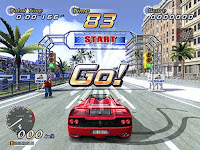Part three of this mini-series of blogs brings us to the letters G, H, and I.
My PlayStation collection has grown slowly over years to well over 120 games and while I do, and in fact just did, call it a ‘collection’, every one of my games was bought to be played and kept because it was enjoyed.
With this in mind I'm allowing myself the caveat of honourable mentions - something I’ve always resisted before.
I’m splitting these up into bite-sized chunks of three or four at a time, so here's the latest batch.
Set in a cyberpunk future, G-Police puts you in control of a hovering police craft that is as close as you can get to a helicopter without the encumberment of rotor blades - it’s power instead provided by a pair of huge thrusters.
Much like Future Cop LAPD this is a mission based shooter. You fly inside huge domed cities, taking on gangs, criminals, and terrorists and generally upholding the law with an enormous amount of firepower.
Despite controls that pre-date the dual-shock gamepad, buzzing between buildings in pursuit of the bad guy’s is a pure joy. The cities themselves are one of the true stars of G-Police, clearly Blade Runner inspired with every available surface covered in advertising and neon and consisting almost entirely of monolithic skyscrapers the only thing in the game better than the environment is the weapons you are given to protect it.
Guns and rockets are the most pedestrian armaments available, with heat seekers and cluster missiles providing a little more sophistication to the art of serving the public trust.
At the top end of your available arsenal are the incredible Hyper Velocity Missiles, one of my favourite weapons in any game, they crack through the air like thunder and inflict massive damage on the target.
Today, one of the best things things about G-Police and it’s sequel is that they were produced and sold in huge quantities, and are therefore available to buy for about a tenner the pair on eBay.
The best of them have something that’s hard to quantify, and Hard Edge, a rather strange beat-em with Resident Evil stylings from SunSoft on the PS1, is absolutely an example of this.
‘Charming’ is probably the best way to describe this game (known as T.R.A.G. in the US), with it’s bulky anime style avatars moving around fairly realistic pre-rendered environments, multiple playable characters, and beat-em-up gameplay ill suited to its tank controls; it’s definitely far from perfect, but it has good ideas and a style all of its own.
Trying to mix exploration and puzzle solving with melee combat, with this type of presentation, is a gambit that doesn’t quite work, but the boss battles scattered throughout the game are it’s saving grace.
Built in the time honoured pattern-memorising mould these encounters are great fun and fairly inventive. Enough so that you’ll want to see the next one which, when you think about, is about as ‘retro’ a motivation as you could ever ask for!
As the ‘Superstar Soccer’ part of the name suggests, this series began with an even larger nod to the superpowered shots and over-the-top saves of yore; with each team having a star player who’s stats in a certain area would far surpass those of the other players.
ISS Pro Evo 2 moved away from this, but in its place were players whose abilities were far in excess of what you would expect from players of their value on the in-game transfer market.
Tijani Banangida, for example, is legendary in the game for offering blistering pace at a bargain basement price.
The gameplay was also a long way from a sports simulation, and although some of that can be put down to hardware limitations, there are design choices present, such as the default camera angle and ease of performing the few available tricks, that suggest lack of horsepower wasn’t the only reason this game didn’t appear to be aiming for sporting accuracy.
It’s ironic then, that the feeling of the game is more like real football than anything else of its age. The pace of the game is spot on, and smart, challenging AI ensure that this is a game that’s just as good to play alone as it is with friends.
For those who don’t enjoy a good soccer game, I’ll point you in the direction of Incredible Crisis, a uniquely bizarre mini-game collection that follows the adventures of a family trying to buy presents for their elderly matriarch's birthday. It’s brilliantly bonkers fun, and another great PS1 game that can still be picked up for a very reasonable price.

















